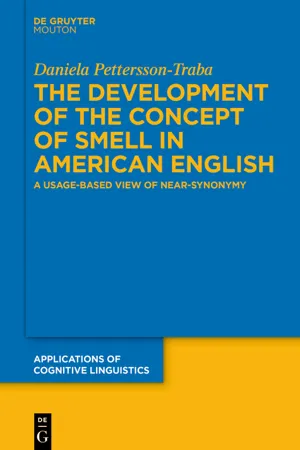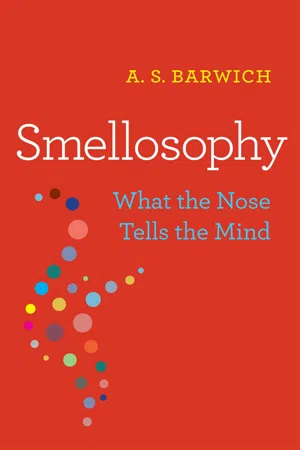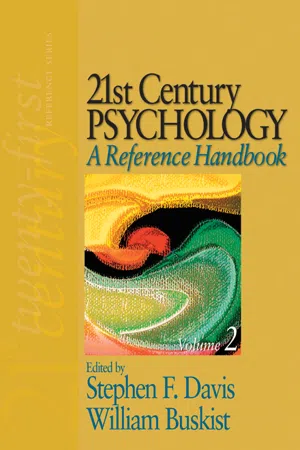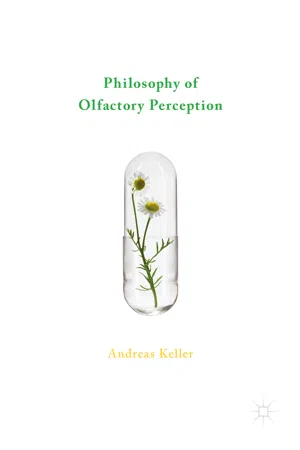Languages & Linguistics
Olfactory Description
Olfactory description refers to the use of language to evoke or describe smells. It involves the use of words and phrases to convey the sensory experience of different scents, such as describing the aroma of a particular food or the fragrance of a flower. Olfactory description can be a powerful tool in literature and communication, allowing writers to create vivid and evocative sensory experiences for their readers.
Written by Perlego with AI-assistance
Related key terms
1 of 5
4 Key excerpts on "Olfactory Description"
- eBook - ePub
The Development of the Concept of SMELL in American English
A Usage-Based View of Near-Synonymy
- Daniela Pettersson-Traba(Author)
- 2022(Publication Date)
- De Gruyter Mouton(Publisher)
In the olfactory domain, several studies have focused on the role of smell in figurative language, both as a target and source domain (cf. for instance, Ibarretxe-Antuñano 1999 ; Digonnet 2018 ; Kövecses 2019) and recently an edited volume including work on the lexicon of olfaction in different languages has been published (cf. contributions in Jędrzejowski and Staniewski 2020). A common claim in the literature is that humans, despite being able to identify and discriminate a wide range of smells, experience difficulties when having to name them (e.g., Ibarretxe-Antuñano 1999 : 36; Yeshurun and Sobel 2010 : 216). This can be one of the reasons why the odor vocabulary has not been researched to the same extent as other domains of perception such as that of color (e.g., Berlin and Kay 1969 ; Wright 2011 ; Biggam 2012 ; Sandford 2016 ; 2018; 2021) or the lexicon related to the other four senses (i.e., hearing, vision, taste, and touch), which have been claimed to be much more extensive and precise in English and other Germanic languages (e.g., Sperber 1975 : 115–116; Digonnet 2018 : 178–179; Winter 2019 : 94, 171). This does not mean, however, that humans have a poor sense of olfaction. On the contrary, the sense of smell is considered to be one of the most diverse ones, with up to one trillion olfactory stimuli being discriminated by humans vs. for instance, only half a million different auditory tones (Bushdid et al. 2014 ; McGann 2017). In fact, it has been demonstrated that languages outside those belonging to the Indo-European family (e.g., Tsimané and Seri, spoken in Bolivia and Mexico, respectively) have a much richer terminology to refer to olfaction (Majid and Burenhult 2014 ; Jędrzejowski and Staniewski 2020 : 3–5) - eBook - PDF
Smellosophy
What the Nose Tells the Mind
- A. S. Barwich(Author)
- 2020(Publication Date)
- Harvard University Press(Publisher)
. . What the heck are you guys talking about?” Odor language is strongly contingent upon the rules of conventionalization. Majid concluded, “If you have conventionalized vocabulary, then it’s something that speakers in the community all share.” It is far from evident how language use connects perception to cognition and vice versa. And so we saw how the intellectual atti-tude, which has traditionally sidelined olfaction as a cognitively unsophisticated sense because of the descriptive challenges in ex-pressing its experience, has followed three mistaken assumptions: that introspection is a solid source for the analysis of perception (which was not the case in flavor), that conscious experience ac-counts for the structure of perception (which ignores unconscious influences shaping this experience), and that language provides a mirror of experience (ignoring that verbalization is a product of cognition and culture that does not provide a “separate tool” for the analysis of conscious perceptual content). All three assump-tions invite a revision of our understanding of odors as cognitive objects. Odor perception cannot be sufficiently accounted for by the “mind’s inner eye” and its expression in propositional format. Fo-cusing on semantics is deceptive. Semantic labels are not unam-biguously representative of the cause of an odor. This point is more than philosophical; it also impacts experimental design. Vosshall argued: “I think that the field has to get away from words. We have Minding the Nose 103 to stop using semantic descriptors for things.” Substituting words for perceptual content overlooks the contextuality of semantics, historical and cultural. Vosshall referenced Andrew Dravnieks’s Atlas of Odor Character Profiles, a compendium of odor descriptors from 1985, which is still routinely used in olfactory psycho-physics. - Stephen F. Davis, William Buskist, Stephen F. Davis, William F. Buskist(Authors)
- 2007(Publication Date)
- SAGE Publications, Inc(Publisher)
The future direction of olfactory research is exciting; it should help our understanding of the more complex visual and audi-tory systems that may have evolved from it. It will make a unique contribution to the study of human consciousness. Finally, it has growing practical relevance to the study of human health and disease. Olfaction is not what you think. Although most of us know that we need eyes to see and ears to hear, most of us do not know that we need a nose to “taste,” yet olfaction is central to our enjoyment of eating and drinking. Indeed, most of us probably regard olfaction as nothing more than an occasional sniff of a flower or the heady whiff of garbage or somebody else’s unwashed body. But olfaction pervades our life in many ways, betraying whether we are likely to develop Alzheimer’s disease or schizophre-nia, and indeed, if some are to be believed, influencing whether others find us attractive, as well as allowing us to recover forgotten memories from childhood. However, as interesting as these things are, they are not the reasons that most psychologists choose to study smell. Rather, it is the beguiling mystery of how it works, a conundrum that is still not resolved and at the moment forms the central focus for many psychologists working in this field. This chapter starts by directly addressing this issue and, as you will see, the picture that emerges is indeed bizarre—what you smell is a memory. Olfaction • 217 THEORY Function In both humans and animals, the basic function of the olfactory system is to detect and recognize biologically relevant chemicals (i.e., food, mates, kin, predators). This is no easy matter. The environment is full of chemicals that can be detected by the olfactory system. In addition, nearly all odors—which we perceive as being discrete entities—are in fact combinations of 10s or 100s of dif-ferent volatile (i.e., smellable) chemicals.- eBook - ePub
- Andreas Keller(Author)
- 2017(Publication Date)
- Palgrave Macmillan(Publisher)
The evidence presented in this chapter shows that olfaction has a strong impact on evaluative emotions, while our capacity to process olfactory information linguistically is very limited. This is not a new insight. Over 2000 years ago Plato wrote that odors “have no name and they have not many, or definite and simple kinds; but they are distinguished only as painful and pleasant” (Plato). Today we know that the reason for the privileged connection between olfaction and evaluative emotions is that the same neuronal networks in the brain that process olfactory information also process emotions. The connection between olfaction and emotions is presumably not the only privileged connection between a perceptual modality and a non-perceptual cognitive process. Vision seems to have a privileged connection to language processes. An analysis of proprioception, the sensing of the relative position and movement of body parts, would reveal a strong connection between proprioception and movement control. That one can find this type of modality-specific connections shows that sensory information from a given modality is made available only to those processes that can use the information for adaptive behaviors. The motor system needs to know the current angle between the forearm and upper arm, so that it can execute directed arm movements. The language system does not need to know the current elbow angle because being able to report the position of your forearm verbally does not convey strong adaptive advantages.The sense of smell has evolved to be an evaluative rather than a descriptive sense. Olfactory information is used mainly to make decisions about rejecting or accepting food or mates (Stevenson 2009 ). Describing verbally the smell of spoiled meat is not crucial for survival; having a negative emotional response to spoiled meat that is stronger than hunger is crucial for an adaptive, odor-guided, behavioral response. The connection between olfaction and emotion is so close that Rachel Herz wondered “whether we would have emotions if we did not have a sense of smell; I smell therefore I feel ?” (Herz 2007 , p. 14). Herz’s thoughts mirror those of Plato, who wondered whether we would have reason without vision and those of Michael Tomasello, who wondered whether we would have language without vision. Summarizing the different relations between perceptual modalities and cognitive processes, Trygg Engen wrote: “Functionally, smell may be to emotion what sight or hearing is to cognition” (Engen 1982 , p. 3).The philosophical impact of the heterogeneity in the connections between perceptual systems and non-perceptual systems is that epistemological accounts that are based on visual perception have to confront the fact that they cover only one, very specialized, form of perception. However, the more interesting point is metaphilosophical. The privileged connection between vision and language is the main reason why I felt that it was necessary to undertake the current research project to expose and correct the misguided ideas in the philosophy of perception that are based on the exclusive engagement with visual perception. The tool of philosophy is language and the connection between vision and language is stronger than the connection between other modalities and language, which gives vision privileged access to the minds of philosophers.
Index pages curate the most relevant extracts from our library of academic textbooks. They’ve been created using an in-house natural language model (NLM), each adding context and meaning to key research topics.



